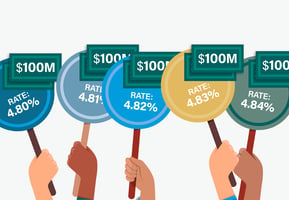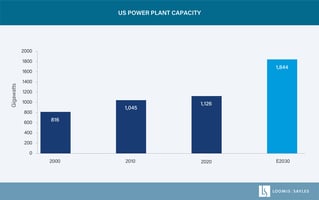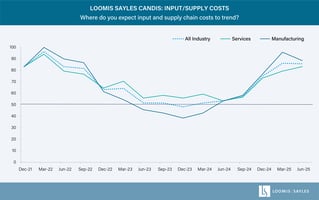
Investment Outlook
Based on fundamentals, we expect the credit cycle’s expansion phase to continue despite ongoing geopolitical risk and trade uncertainty.
Mercurial geopolitical tensions in the Middle East could contribute to financial market instability broadly and oil supply more narrowly—all with potentially very negative consequences for global growth. While we recognize the dual challenges of geopolitical risks and tariff uncertainty ahead, fundamentals still support US economic expansion, driven by consumers and corporate profitability. We expect profit growth to broaden across sectors and continue into 2026. With regard to inflation, prices may experience a temporary pop as companies pass through tariff-related cost increases. However, the Federal Reserve will likely look past this “one-time” price hike, rather than respond by tightening policy.
The global growth backdrop is somewhat cloudy. However, the risk of global trade seizing up and causing widespread recession appears greatly diminished. We see the potential for trade deals, temporary truces and tariff pause extensions to emerge this summer. That said, an elevated effective tariff rate—around 15%—seems likely.
Investment Themes
Our take on macro drivers and major asset classes at a glance.

Macroeconomic Drivers
Given the backdrop of decent growth, we think aggressive central bank easing is unlikely and anticipate 25-basis-point cuts in October and December.

Corporate Credit
Risk premiums across credit markets may remain compressed if companies successfully navigate tariff-related uncertainties.

Government Debt & Policy
Rising bond yields signal that the global economic expansion is likely to continue, even with inflation slightly above central bank targets.

Currencies
Foreign currency performance has been strong year to date and we expect the trend to continue.

Potential Risks
The temporary halt in imposing tariffs allowed markets to recover and get back to trading on fundamentals. Excessive market volatility could return if trade policies revert to “Liberation Day” tariff levels.
- Solid bottom-up fundamentals have led to relatively expensive valuations across credit and equity markets.
- Higher-income consumers—who account for the bulk of spending—remain in good shape assisted by the wealth effect. However, those in lower-income brackets are under some financial pressure. Nevertheless, labor market health and ongoing job creation should keep consumer spending on firm footing.
- US economic growth may drift below long-term trend levels later this year, but our estimated recession probability has continued to decline and now sits at 20%.
- Given the backdrop of decent growth, we think aggressive central bank easing is unlikely. We anticipate 25-basis-point cuts in October and December.
- While some progress may be made in shrinking the US budget deficit, we are not optimistic that the US administration’s target of 3% to 4% of GDP will be achieved over the next three years.
- Despite deteriorating US fiscal health, global investors do not appear to be bailing out of US assets. Treasurys should remain a dependable hedge in risk-off environments.
- In the Middle East, much depends on regional reaction functions principally between Israel, Iran and the US. Each player is operating in the “fog of war” in a situation that demands increasingly speedy reaction times. The failure of all parties to restore mutual deterrence is creating escalatory inertia that makes the risks difficult to overstate.
- With regard to oil, the most significant and enduring threat to global supply is the potential closure of the Strait of Hormuz. Approximately 17 million barrels per day of crude oil and petroleum products—representing about 15% of global demand and roughly 40% of global exports—travel on this waterway.
- As a rule of thumb, a disruption of one million barrels per day of oil exports can result in an estimated 10% rise in oil prices. If ship traffic through the strait is disrupted, global demand (and eventually economic growth) will have to adjust substantially lower.
Globally, rising long-end bond yields appear to be simply restoring term premiums.
Investors demand higher compensation for holding longer-duration bonds.
Source: Bloomberg, as of 16 June 2025.
The chart presented above is shown for illustrative purposes only. Used with permission from Bloomberg. Some or all of the information on this chart may be dated, and, therefore, should not be the basis to purchase or sell any securities. The information is not intended to represent any actual portfolio. Information obtained from outside sources is believed to be correct, but Loomis Sayles cannot guarantee its accuracy. This material cannot be copied, reproduced or redistributed without authorization.
Past performance is no guarantee of future results.
Corporate Credit
Geopolitical, fiscal and monetary policy uncertainties have a tendency to drive wider spreads, but typically not for long.
- Based on bottom-up fundamental analysis, our Credit Research Team suggests 87% of Bloomberg US Aggregate Index industries are in the expansion phase of the credit cycle.
- However, during the past quarter, our Credit Research Analysts grew more cautious regarding the outlook for credit health. As of mid-June, 7% of industries under their coverage had a positive credit outlook compared to 29% last March.
- Concerns about tariff policy and slower domestic economic growth are predominantly responsible for our analysts' wary credit outlooks.
- That said, our risk premium framework suggests corporate health is in a good place. Estimated credit losses due to downgrades within investment grade or defaults in high yield are low and near historical averages for the expansion phase of the credit cycle.
A spread widening event due to corporate profit or economic recession is not in our six-month forecast.
Investor demand for corporate credit has been strong and that should continue.
Source: Bloomberg, JP Morgan, as of 13 June 2025.
The chart presented above is shown for illustrative purposes only. Used with permission from Bloomberg. Some or all of the information on this chart may be dated, and, therefore, should not be the basis to purchase or sell any securities. The information is not intended to represent any actual portfolio. Information obtained from outside sources is believed to be correct, but Loomis Sayles cannot guarantee its accuracy. This material cannot be copied, reproduced or redistributed without authorization.
Indices are unmanaged. It is not possible to invest directly in an index.
Past performance is no guarantee of future results.
Government Debt & Policy
Central banks are set to move away from restrictive policies, but aggressive rate cuts should not be necessary.
- US budget negotiations are ongoing. The proposed budget raises the debt ceiling and Congress has until mid-August to pass a budget and avoid a technical default for the federal government.
- Uncertainty surrounding the US fiscal position can create anxiety amongst fixed income investors. So far the Treasury market is taking budget negotiations in stride.
- The US labor market is relatively stable. We think the Federal Reserve will maintain monetary policy through the summer unless there is a significant shock to the economy.
- US duration looks attractive even with lower odds of recession. Our interest rate forecast includes a moderate bond rally over the next six months.
- In our view, emerging market local-currency and sovereign bonds remain preferred markets. The yield advantage over US Treasurys is significant in several countries.
US fiscal imbalances are on an unstable path, but we do not believe that factor alone is driving Treasury market performance.
Long-term government bond yields have been on the rise in most countries, not just in the US.
Source: Bloomberg, as of 17 June 2025.
The chart presented above is shown for illustrative purposes only. Used with permission from Bloomberg. Some or all of the information on this chart may be dated, and, therefore, should not be the basis to purchase or sell any securities. The information is not intended to represent any actual portfolio. Information obtained from outside sources is believed to be correct, but Loomis Sayles cannot guarantee its accuracy. This material cannot be copied, reproduced or redistributed without authorization.
Currencies
US exceptionalism appears on pause for now. In a global risk-on environment, we think diversifying portfolios and holding non-dollar exposure makes sense.
- With the probability of recession decreased globally, a flight-to-safety bid is no longer buoying the US dollar.
- The US administration’s willingness to negotiate trade deals is driving our favorable view of non-US-dollar assets.
- In Europe—particularly in Germany—the shift toward more expansionary fiscal policy should raise long-term-trend growth rates for those economies.
- Improved global growth prospects in developed and emerging markets have been attracting capital, a trend that could last for several quarters or longer.
- Geopolitics introduce volatility, which presents a risk to our positive non-US-dollar view.
- While we remain cautious on China, a substantial trade deal could present an upside surprise.
The Loomis Sayles Broad FX Index could break out of a nearly three-year range, possibly heading toward 2021 highs.
The Loomis Sayles Broad FX Index is an equally-weighted basket of 23 currencies measured relative to the US dollar.
Source: Bloomberg, as of 16 June 2025.
The chart presented above is shown for illustrative purposes only. Used with permission from Bloomberg. Some or all of the information on this chart may be dated, and, therefore, should not be the basis to purchase or sell any securities. The information is not intended to represent any actual portfolio. Information obtained from outside sources is believed to be correct, but Loomis Sayles cannot guarantee its accuracy. This material cannot be copied, reproduced or redistributed without authorization.
Indices are unmanaged. It is not possible to invest directly in an index.
Past performance is no guarantee of future results.
Global Equities
The macro backdrop may be fraught with headline risk, but history suggests earnings growth can propel equities higher.
- Equity markets could consolidate in early summer after such strong spring performance. Nevertheless, we anticipate strong uptrends to continue in the US, Europe and emerging markets.
- US equities demand a premium valuation given relatively better profit margins and greater exposure to high-growth companies. However, the S&P 500 Index does appear expensive relative to global peers.
- We are optimistic about global equity markets heading into the second half of 2025. Earnings estimates for next year indicate nearly double-digit growth rates for the US, Europe, Japan and emerging markets.
Relative to value stocks, superior underlying fundamentals should drive growth stock outperformance long term.
Value sectors, such as financials and industrials, should trade well, but we believe technology and communication services can do better.
Source: Bloomberg, MSCI, as of 16 June 2025. Rising line indicates Growth Index outperformance.
Neither MSCI nor any other party involved in or related to compiling, computing or creating the MSCI data makes any express or implied warranties or representations with respect to such data (or the results to be obtained by the use thereof ), and all such parties hereby expressly disclaim all warranties of originality, accuracy, completeness, merchantability or fitness for a particular purpose with respect to any of such data. Without limiting any of the foregoing, in no event shall MSCI, any of its affiliates or any third party involved in or related to compiling, computing or creating the data have any liability for any direct, indirect, special, punitive, consequential or any other damages (including lost profits) even if notified of the possibility of such damages. No further distribution or dissemination of the MSCI data is permitted without MSCI’s express written consent.
The chart presented above is shown for illustrative purposes only. Used with permission from Bloomberg. Some or all of the information on this chart may be dated, and, therefore, should not be the basis to purchase or sell any securities. The information is not intended to represent any actual portfolio. Information obtained from outside sources is believed to be correct, but Loomis Sayles cannot guarantee its accuracy. This material cannot be copied, reproduced or redistributed without authorization.
Indices are unmanaged. It is not possible to invest directly in an index.
Past performance is no guarantee of future results.
Potential Risks
Geopolitical turmoil in the Middle East, on its own, should not disrupt fundamentals of most companies.
- Payroll growth in the US has been easing and initial jobless claims are up slightly too. We believe this economic expansion hinges on a strong labor market and consumer spending.
- Risk premiums are slim across US credit and equity markets, which leaves them vulnerable to exogenous shocks or earnings disappointments.
- While often discussed in mainstream media, the so-called bond vigilantes have not appeared.
Asset Class Outlook
Our outlook for most markets is positive, but we acknowledge that valuations are not inexpensive.
Author
Craig Burelle
Global Macro Strategist, Credit
Disclosure
This marketing communication is provided for informational purposes only and should not be construed as investment advice. Any opinions or forecasts contained herein reflect the subjective judgments and assumptions of the authors only and do not necessarily reflect the views of Loomis, Sayles & Company, L.P. Investment recommendations may be inconsistent with these opinions. There is no assurance that developments will transpire as forecasted and actual results will be different. Data and analysis do not represent the actual or expected future performance of any investment product. Information, including that obtained from outside sources, is believed to be correct, but Loomis Sayles cannot guarantee its accuracy. This information is subject to change at any time without notice. Intended for institutional investors and investment professional use only.
Diversification does not ensure a profit or guarantee against a loss.
Market conditions are extremely fluid and change frequently.
Commodity, interest and derivative trading involves substantial risk of loss.
Indices are unmanaged and do not incur fees. It is not possible to invest directly in an index.
Any investment that has the possibility for profits also has the possibility of losses, including the loss of principal.
Past performance is no guarantee of future results.
LS Loomis | Sayles is a trademark of Loomis, Sayles & Company, L.P. registered in the US Patent and Trademark Office.
8107932.1.1



